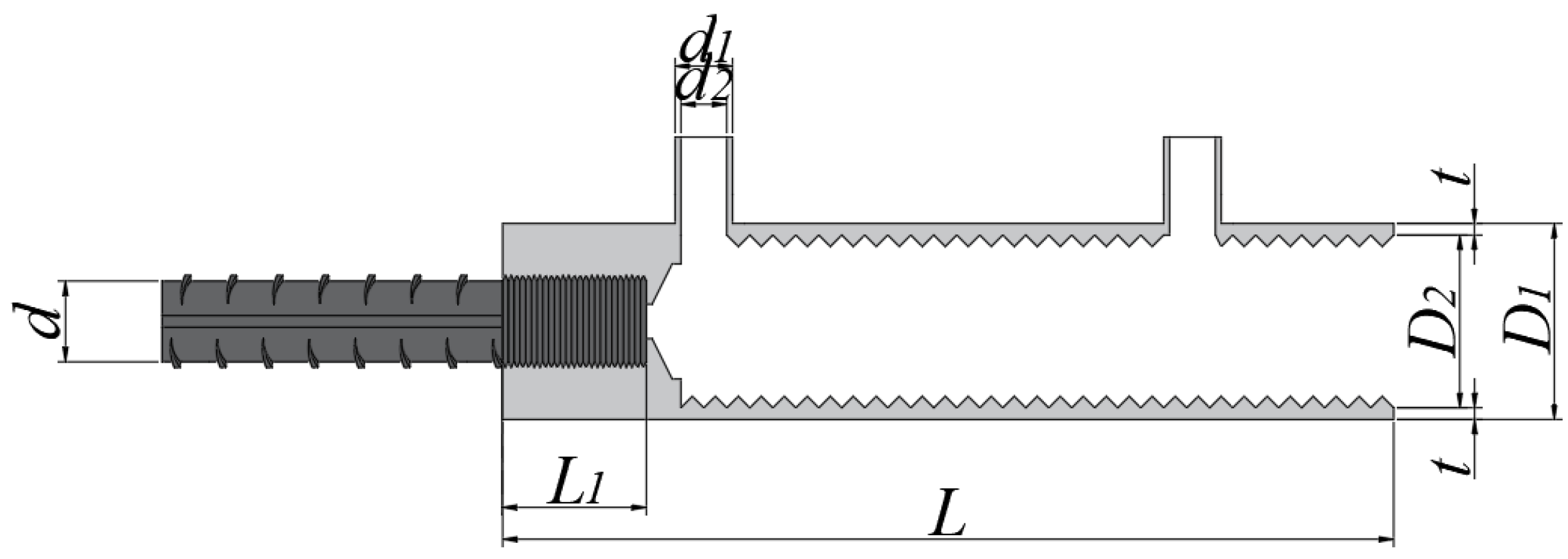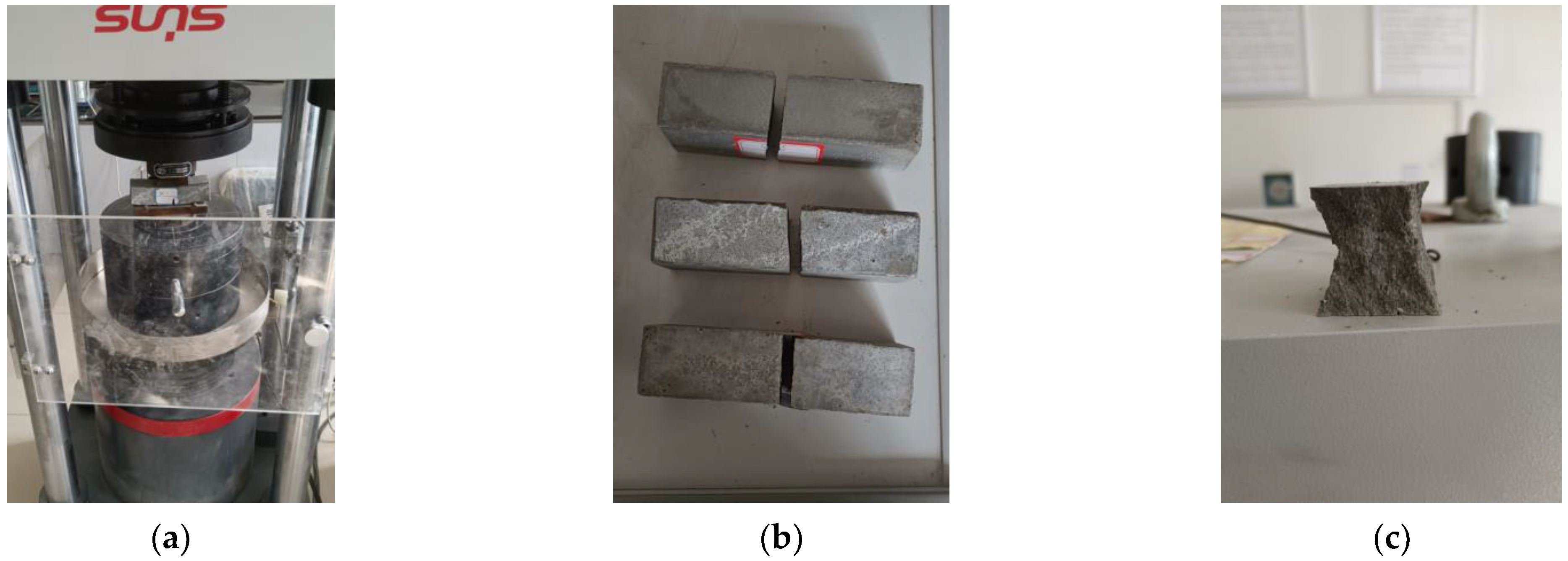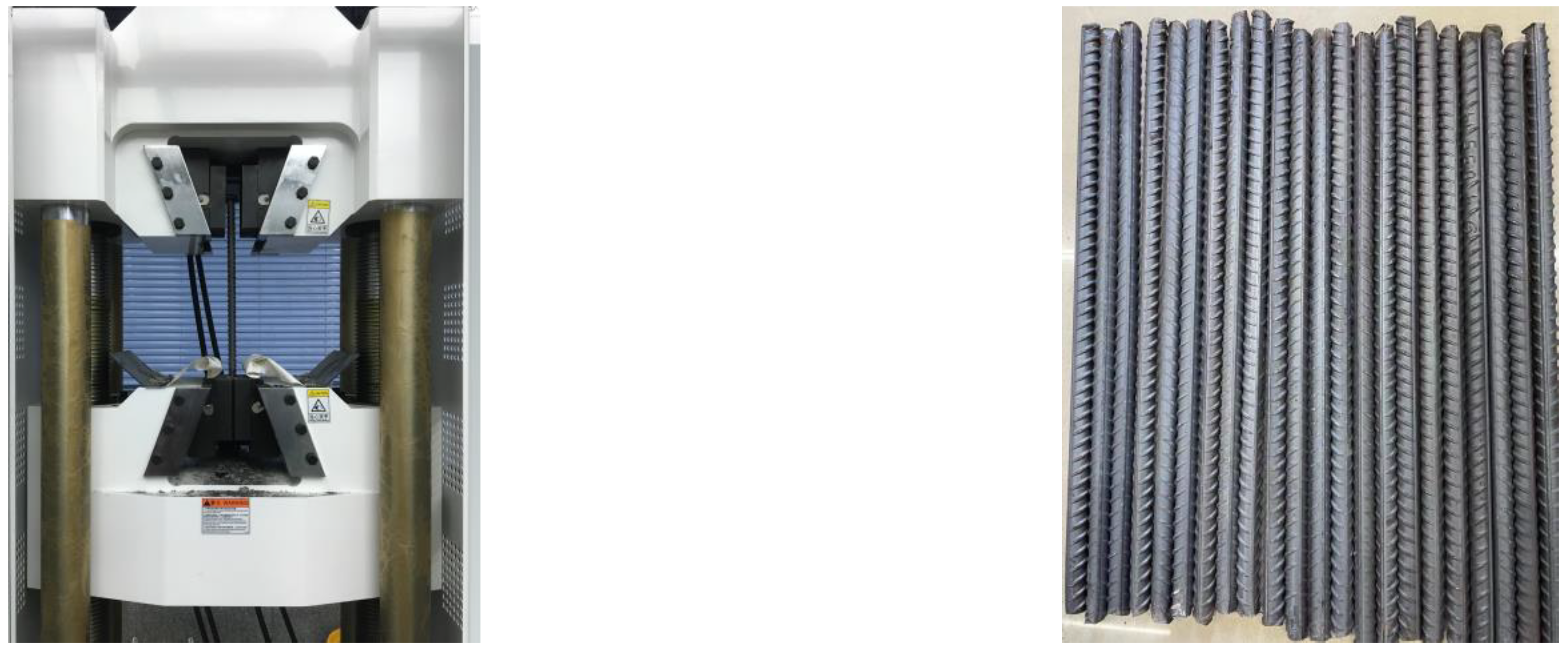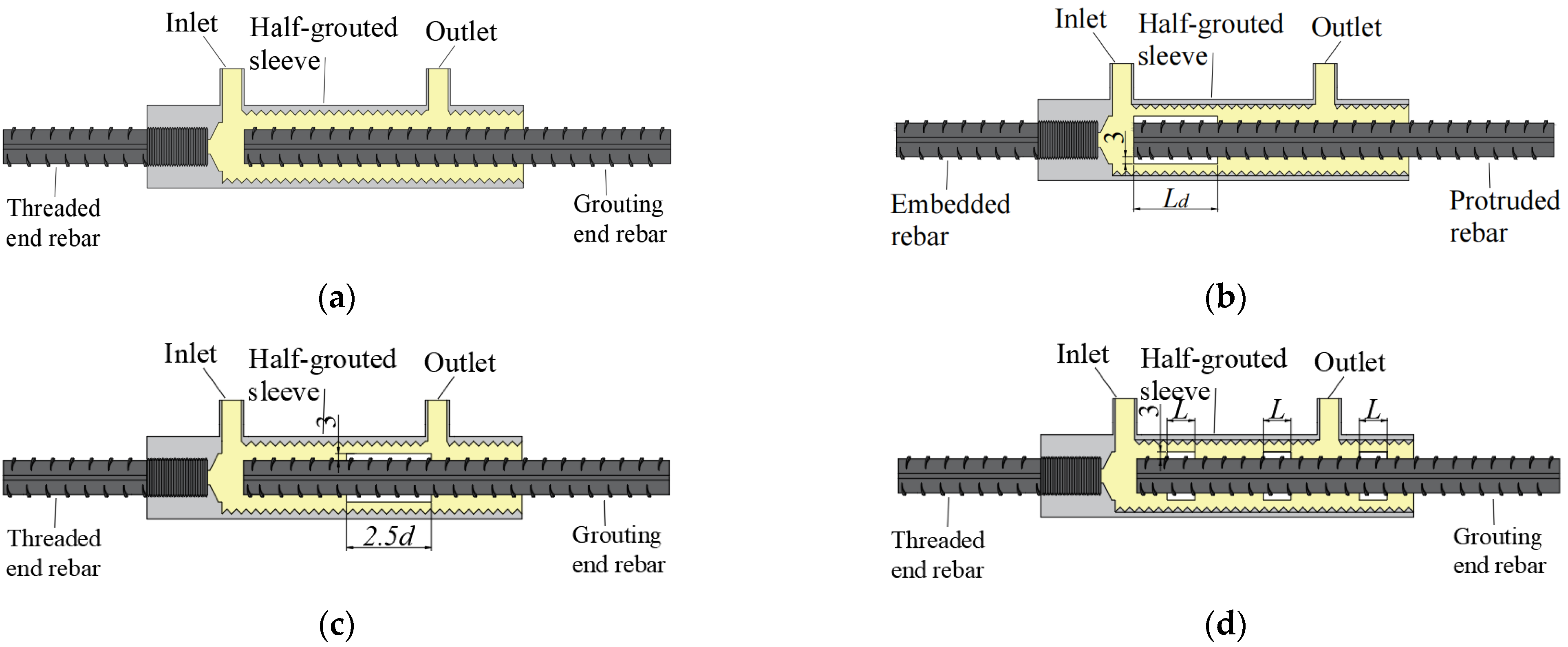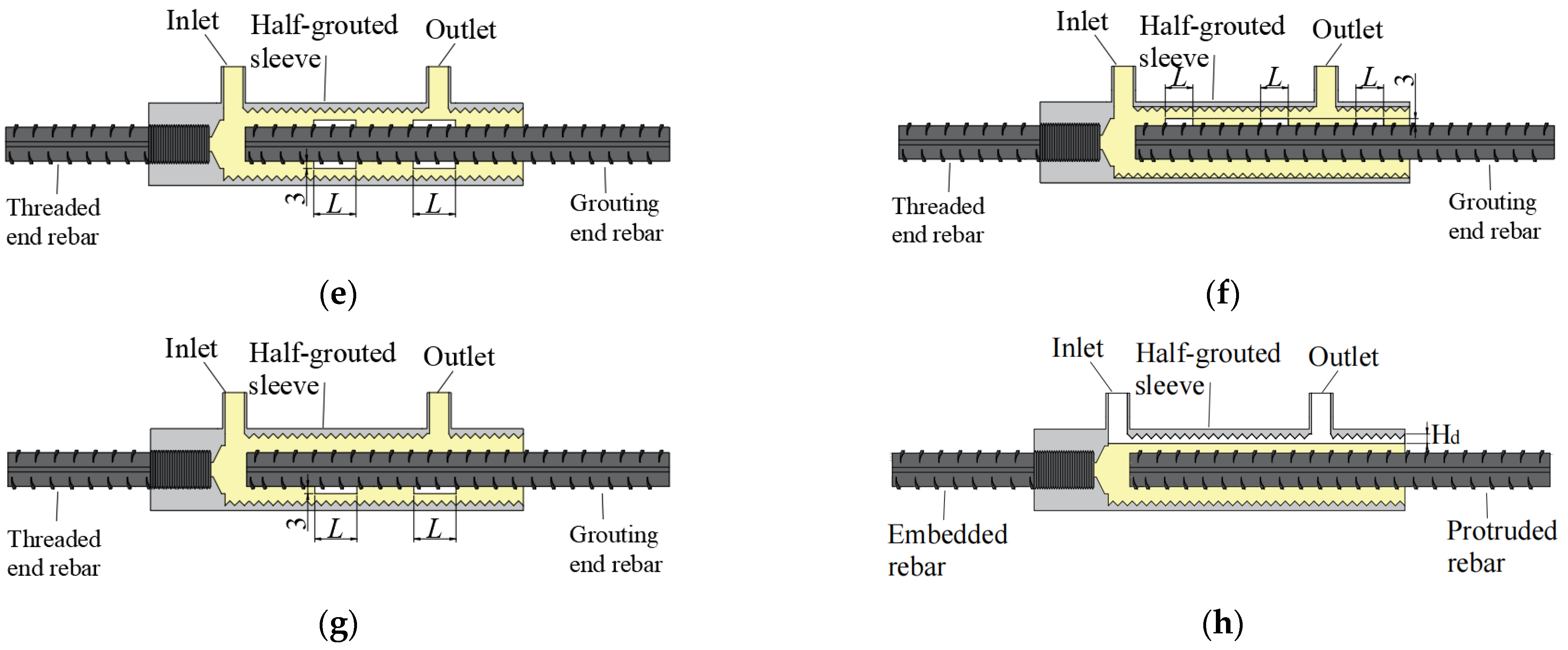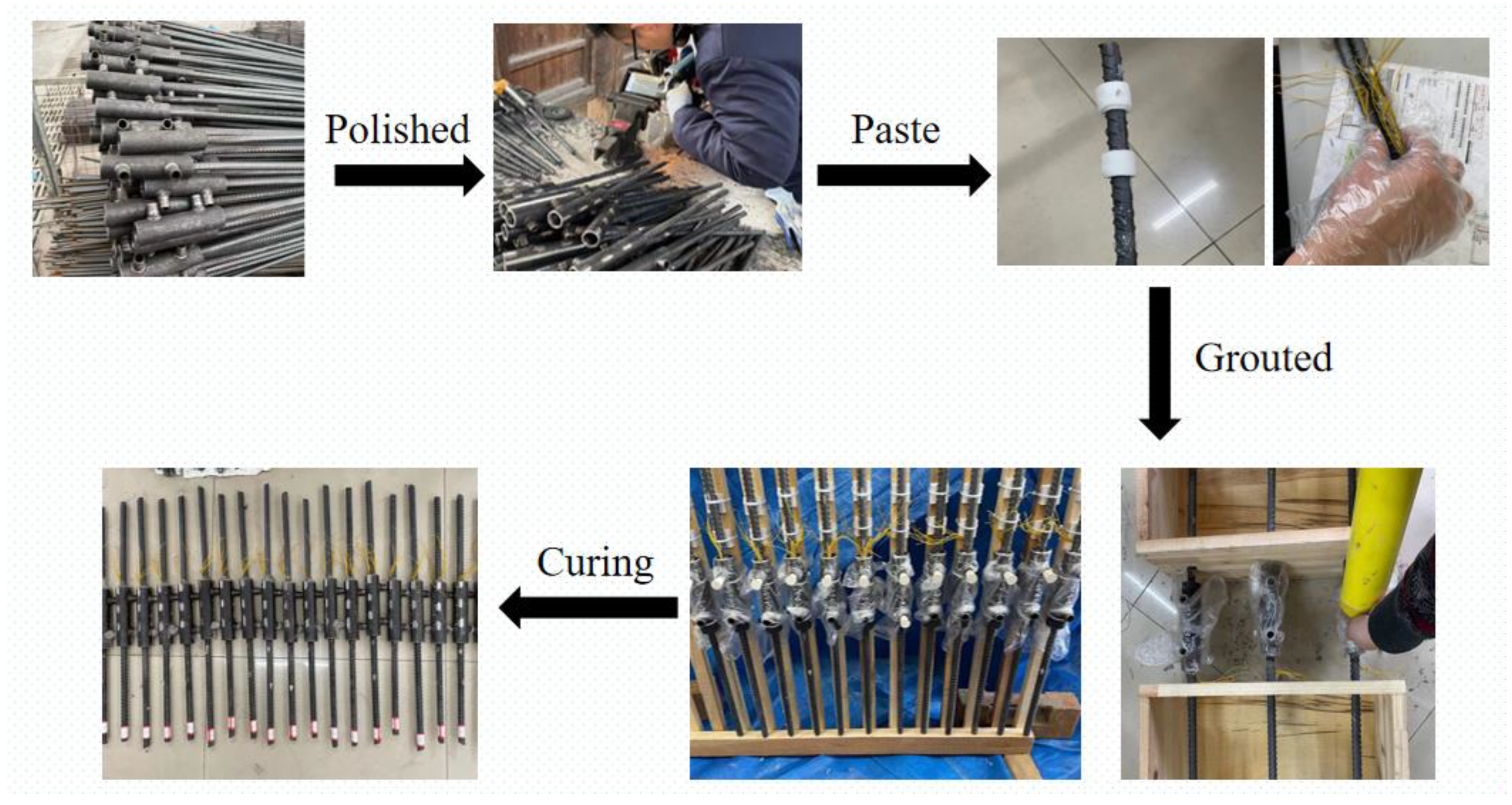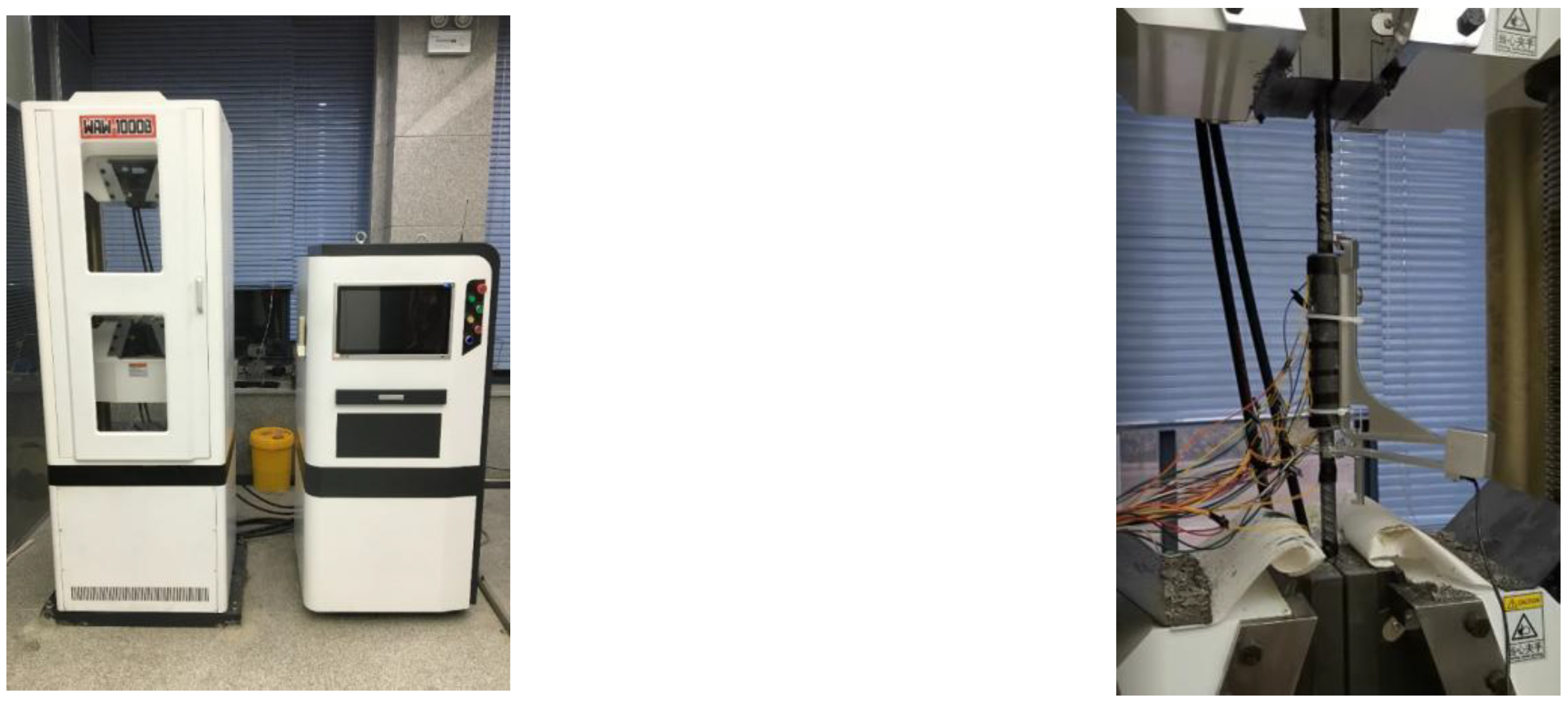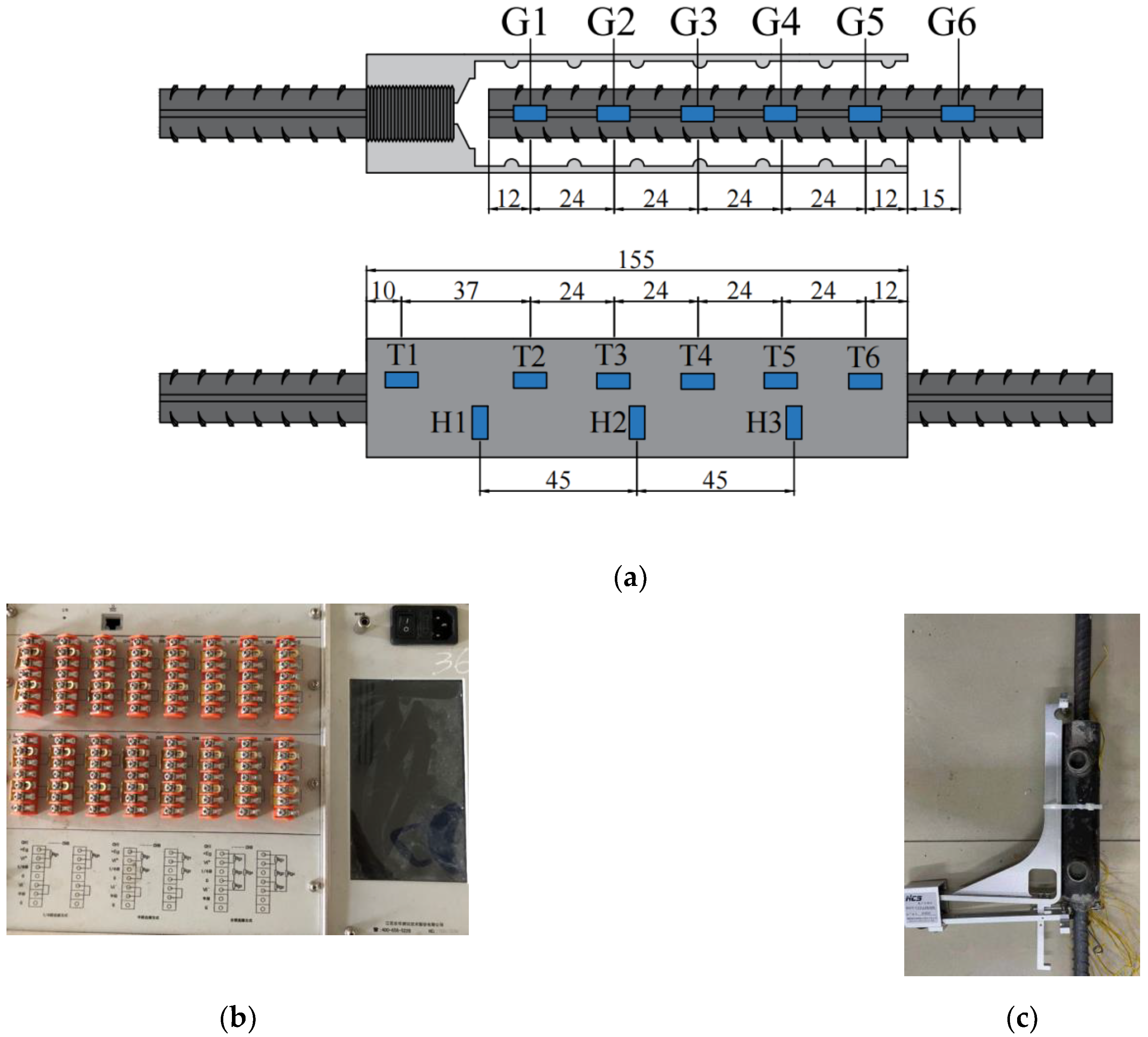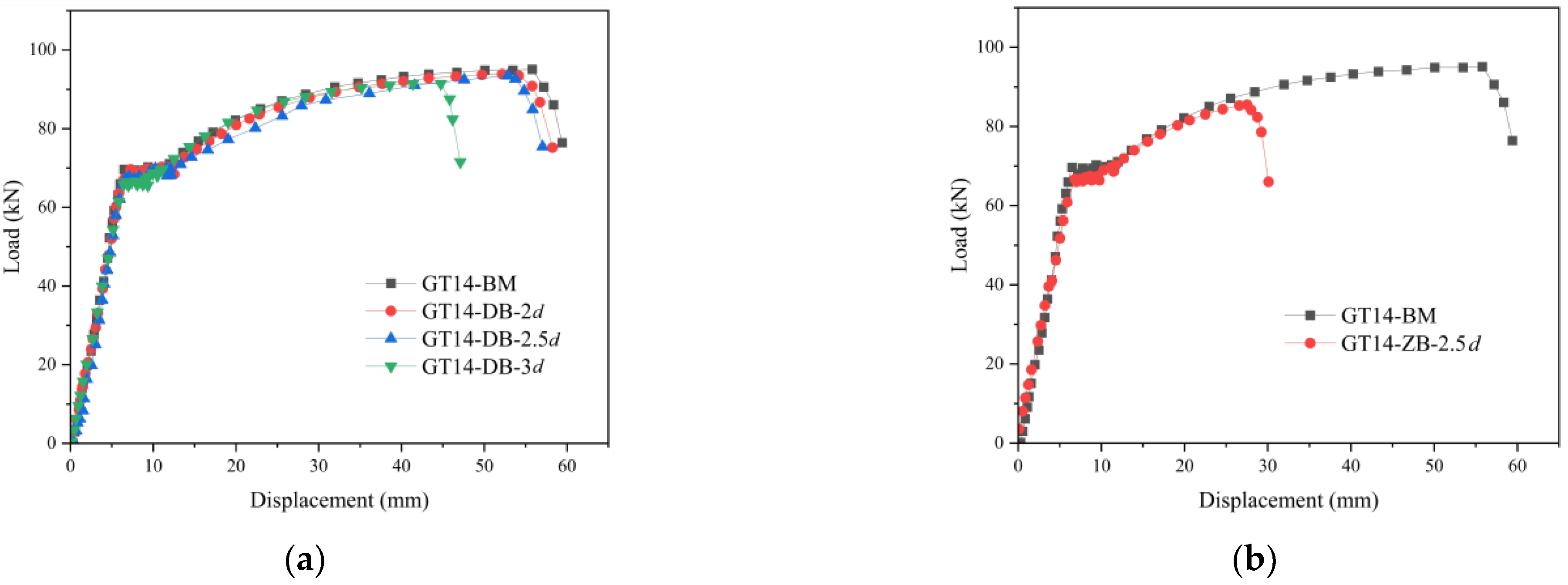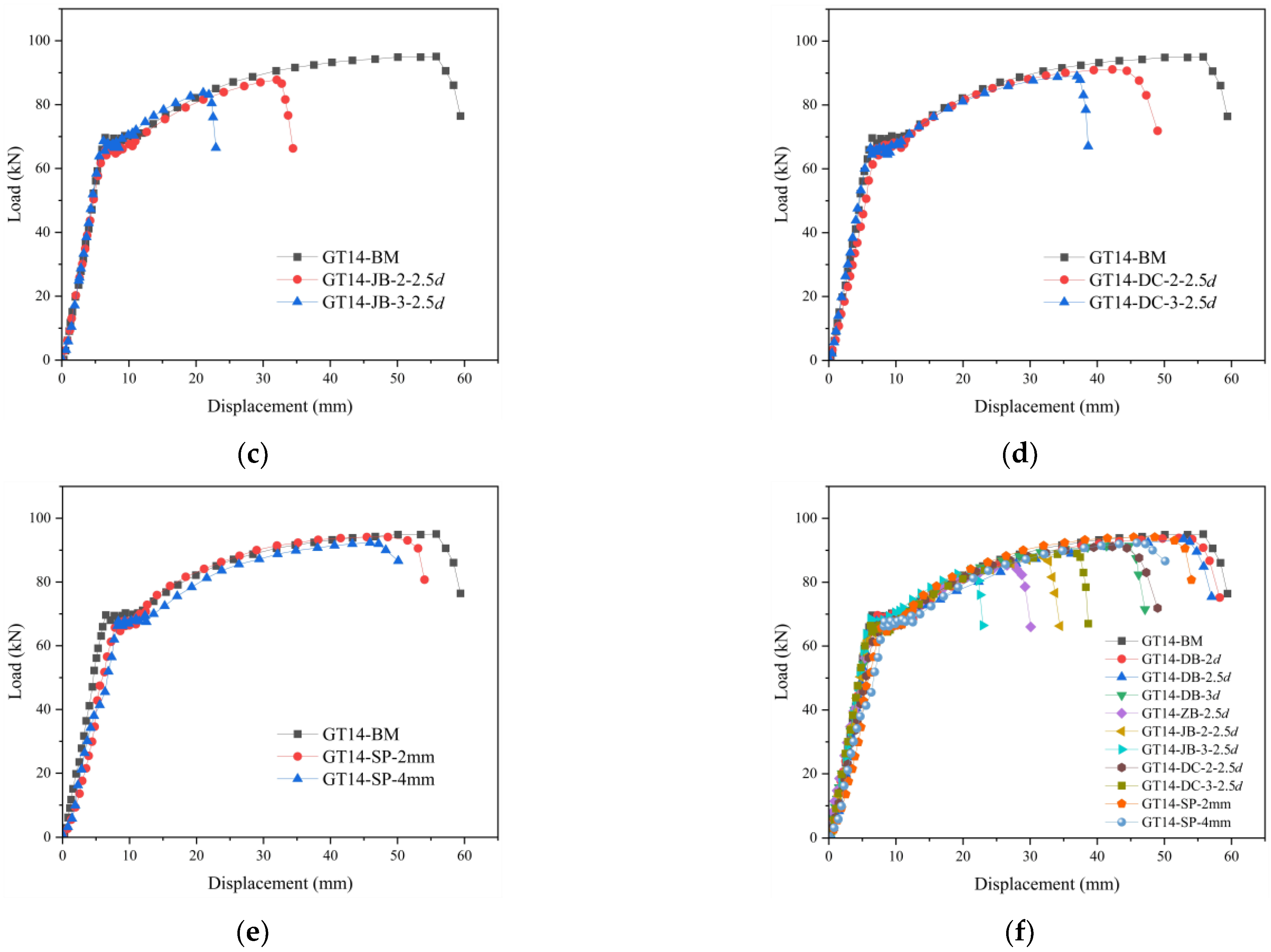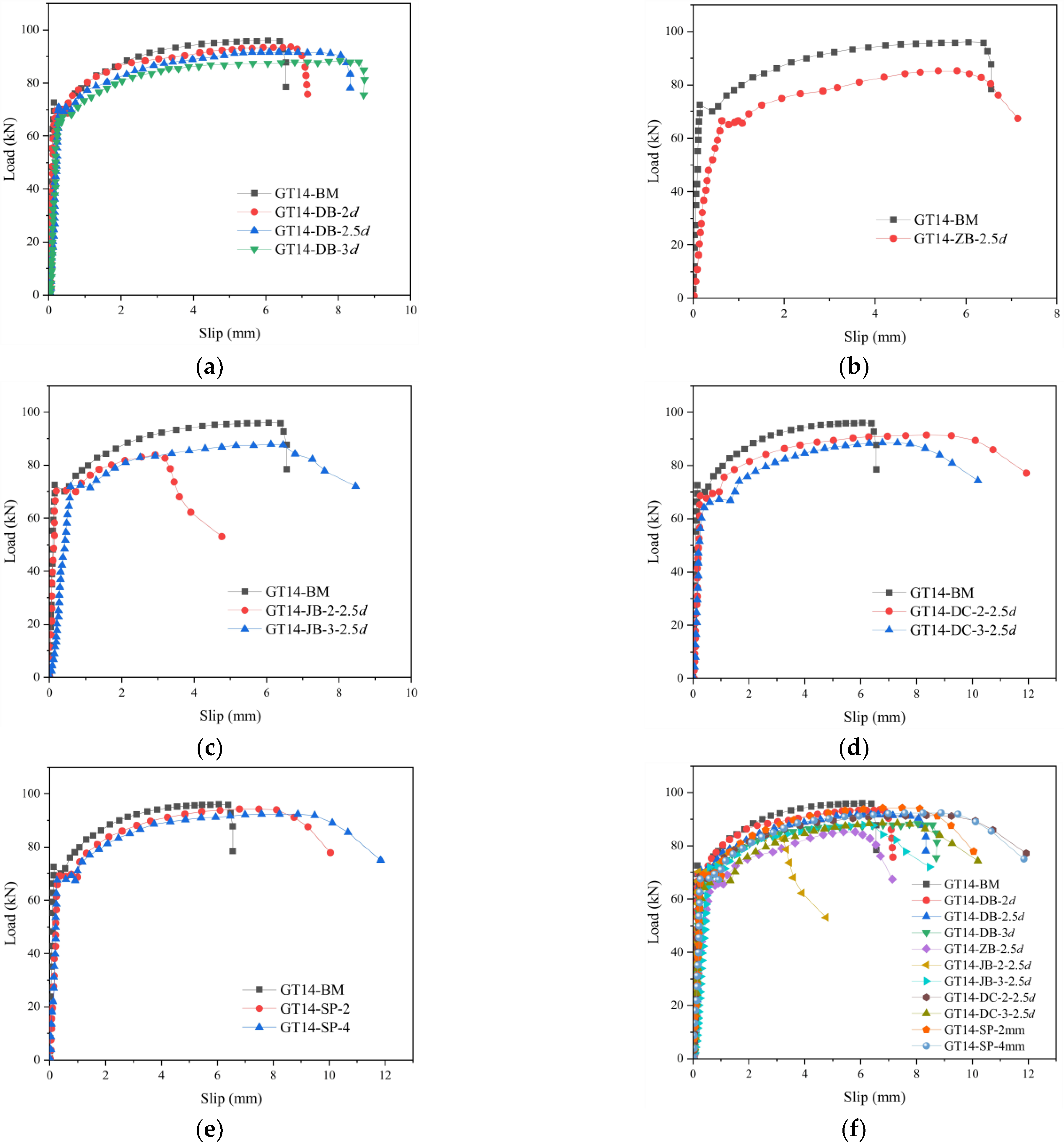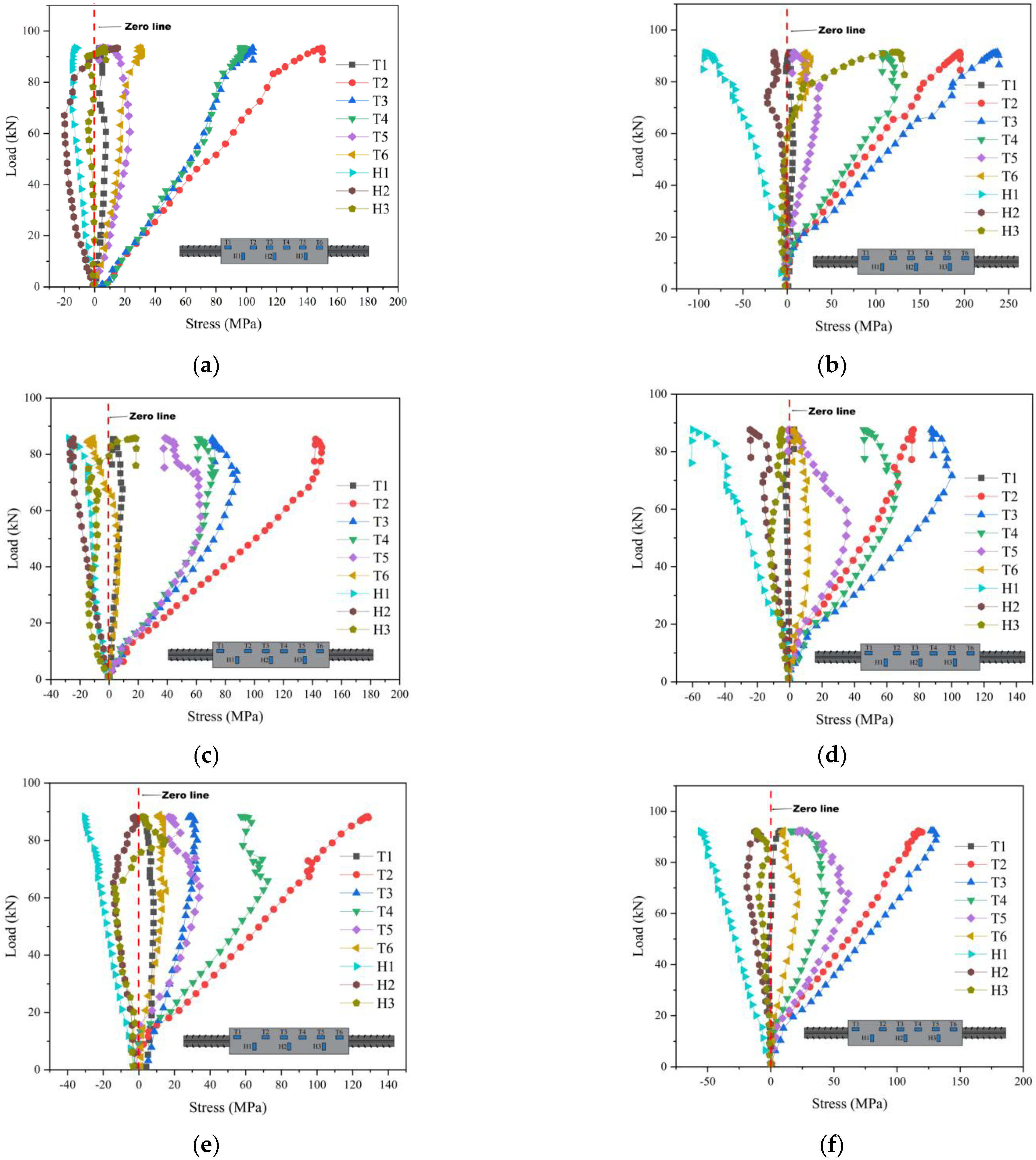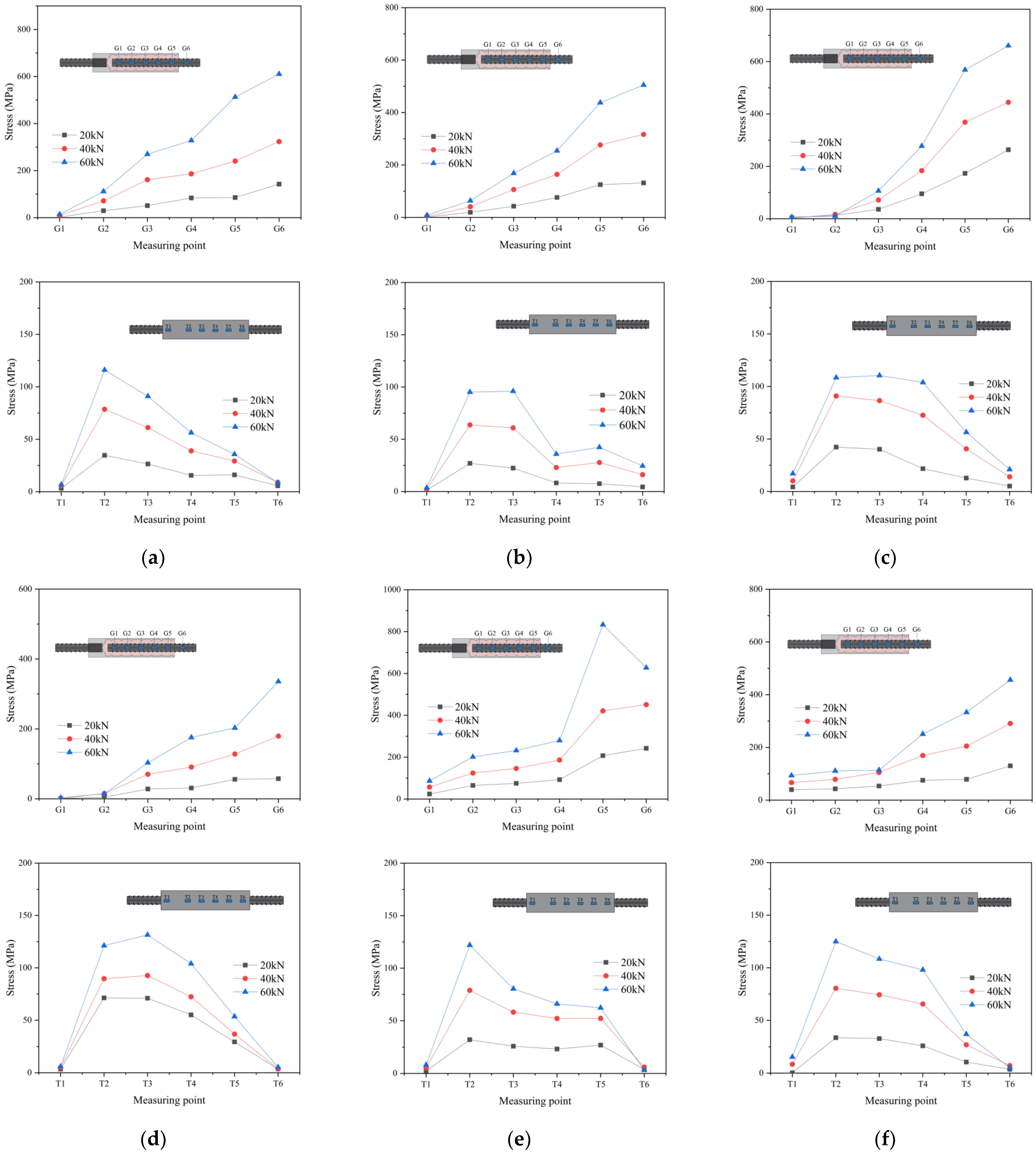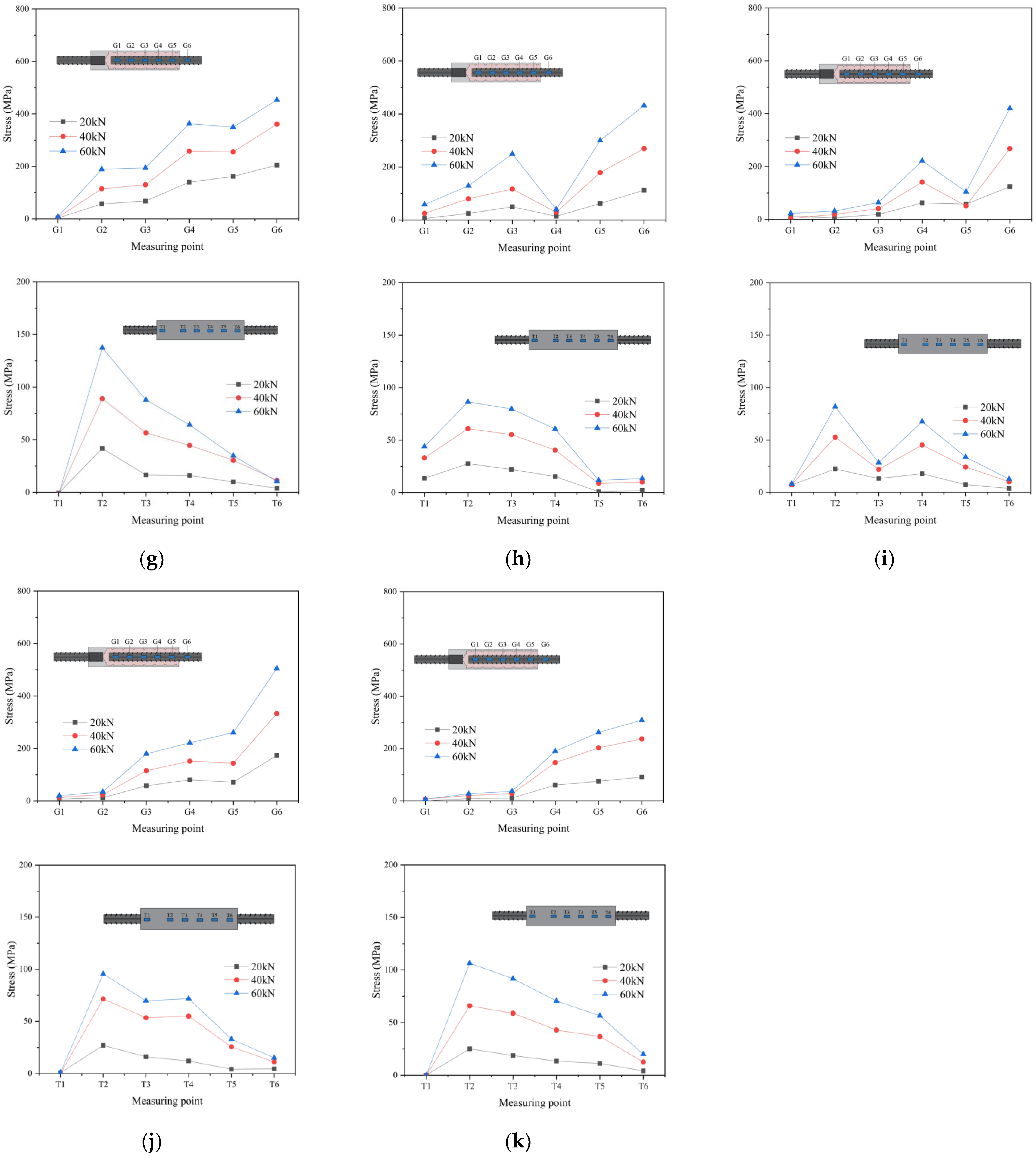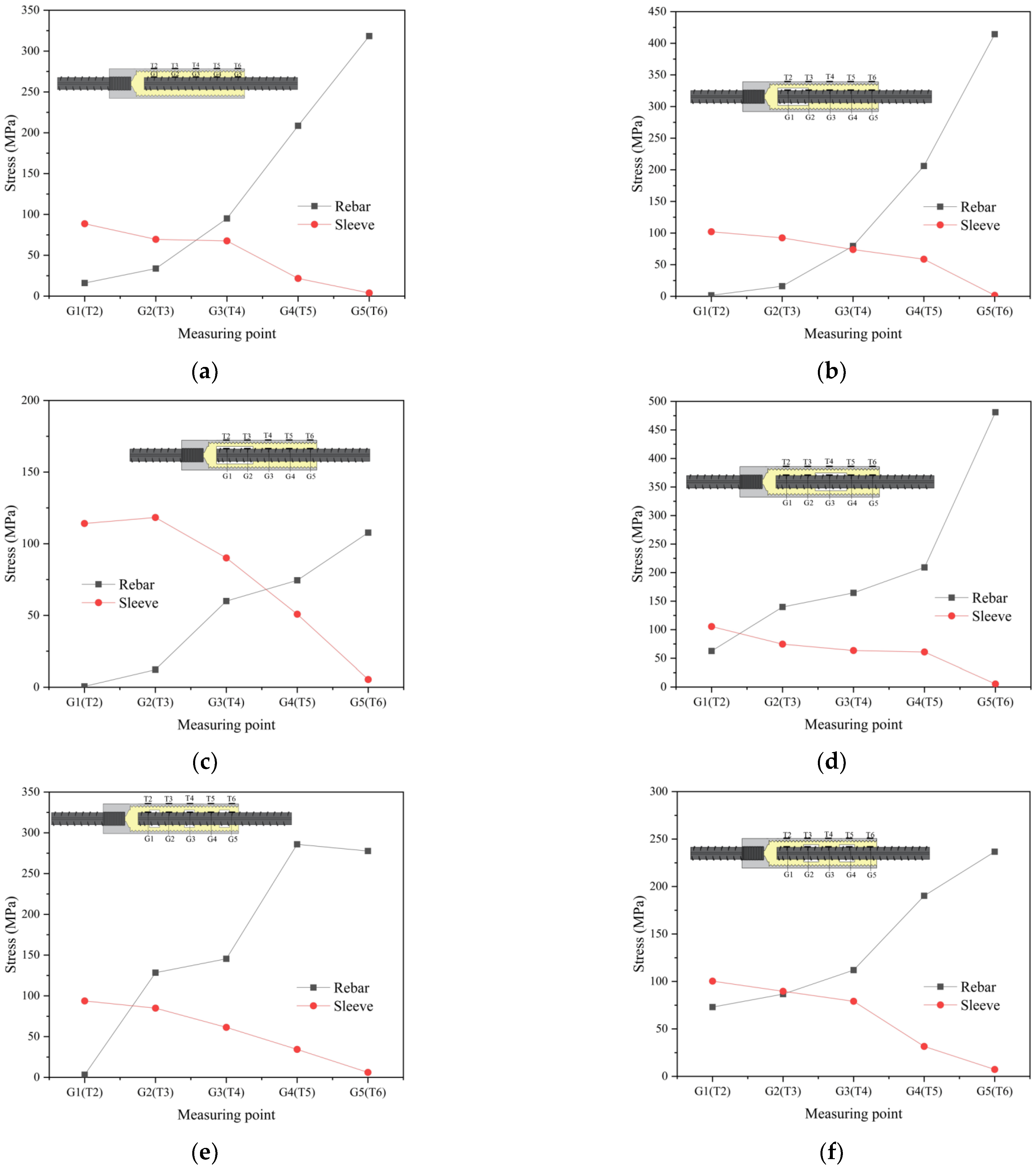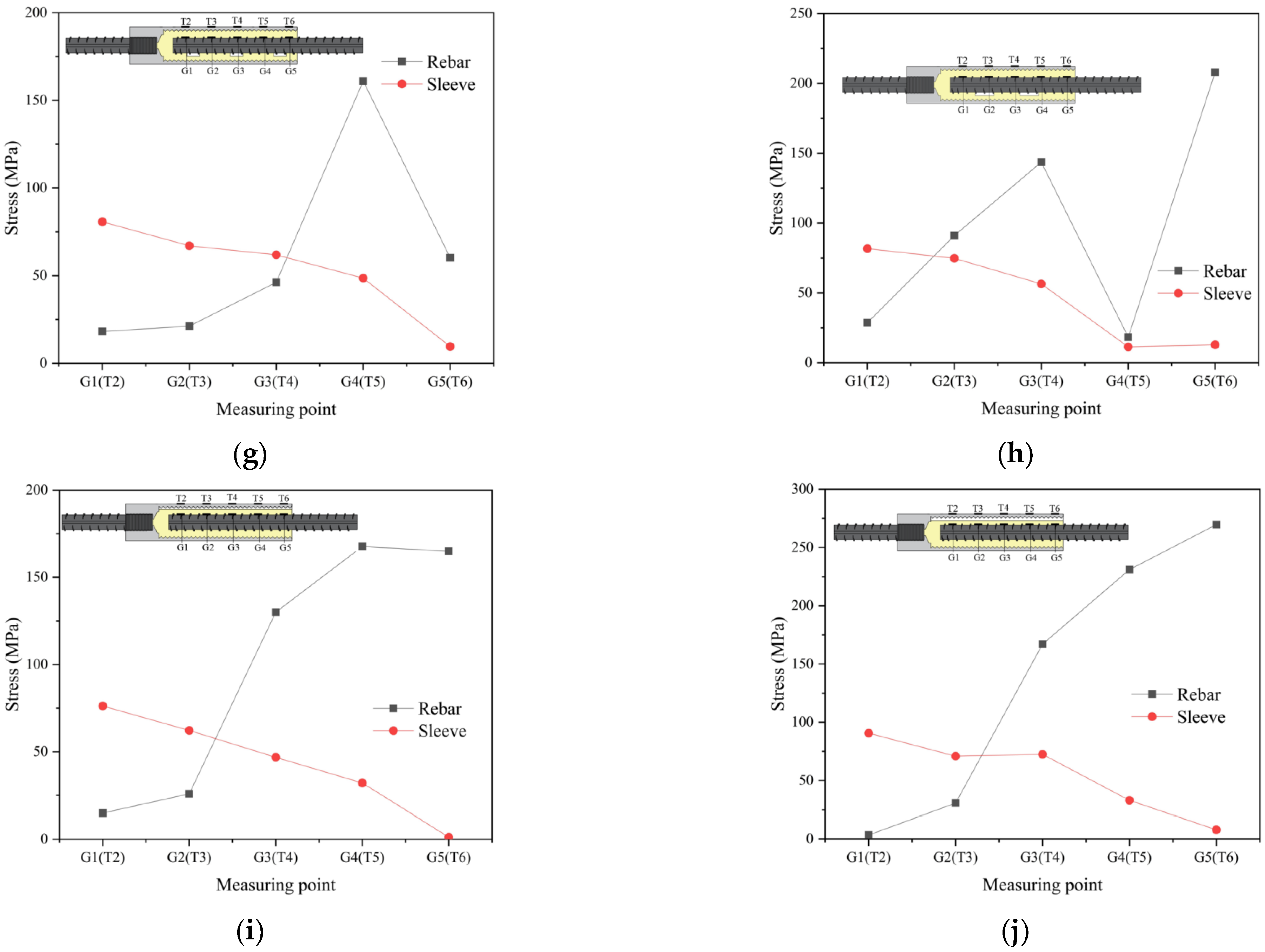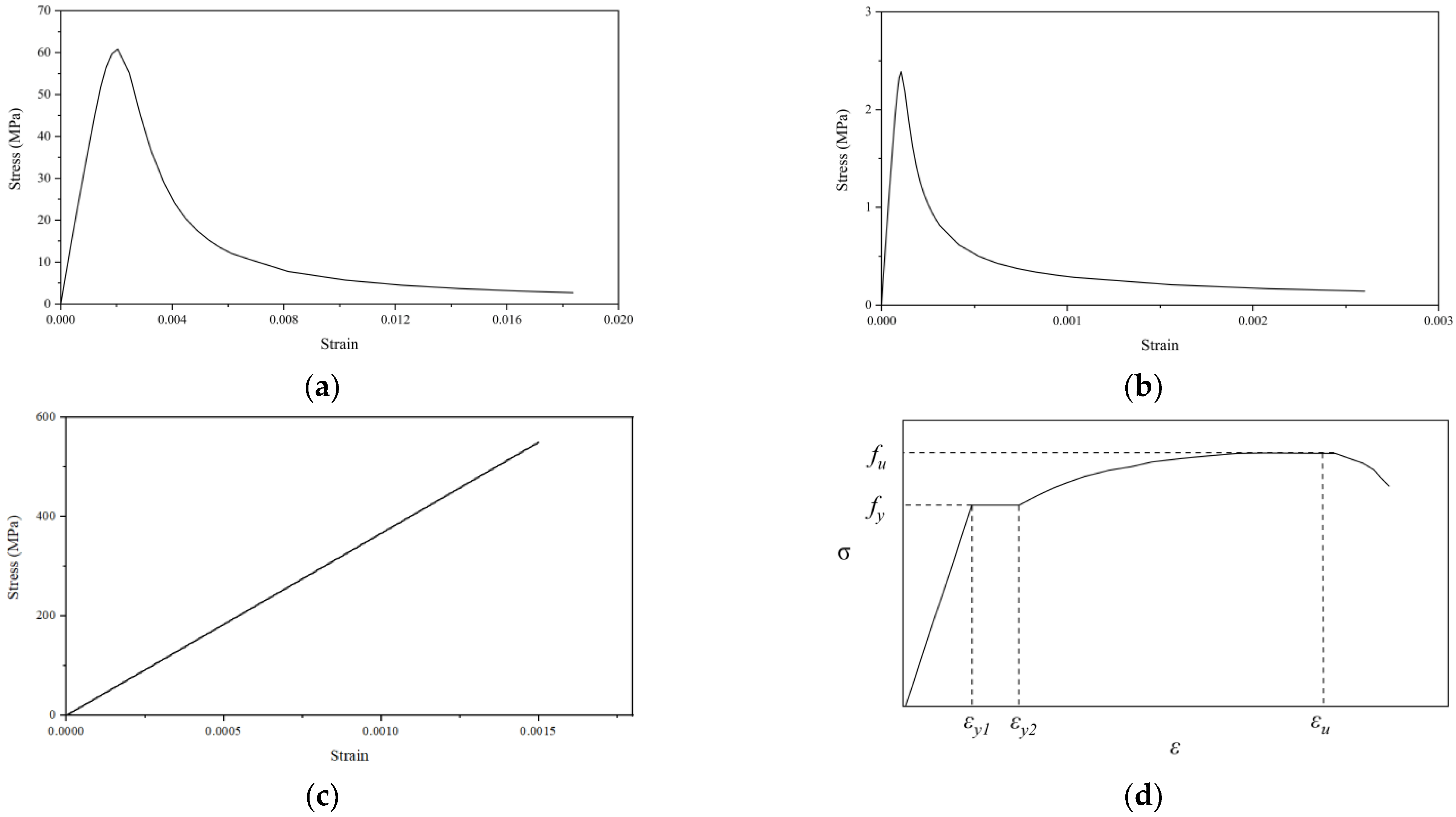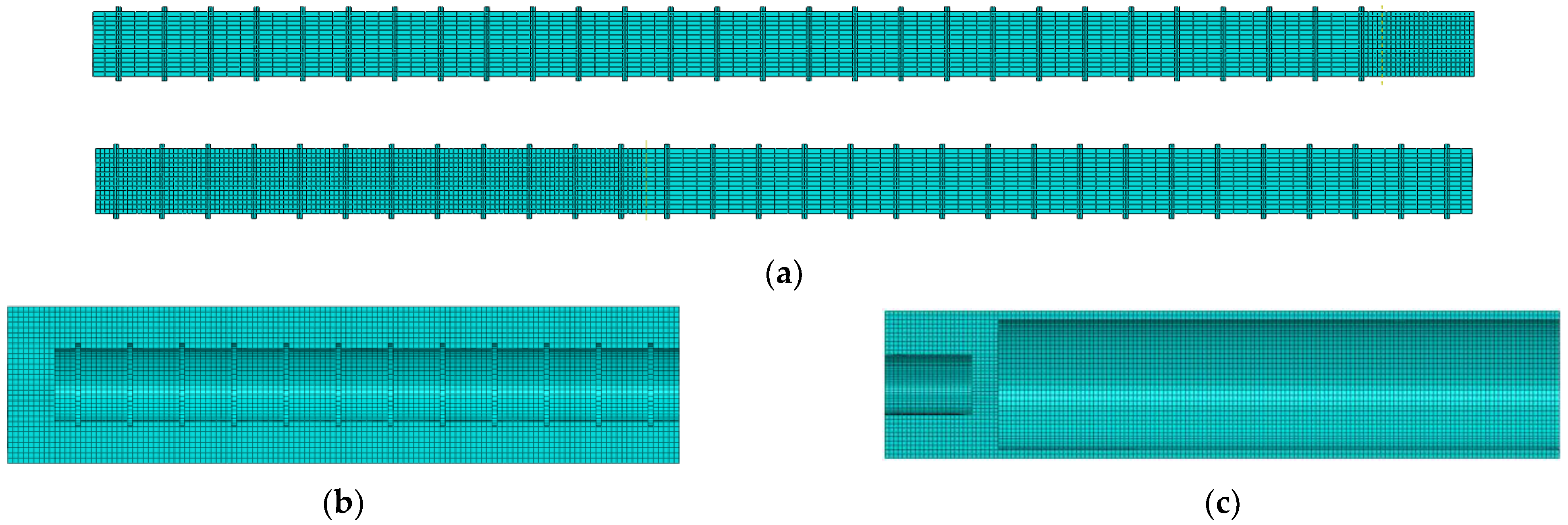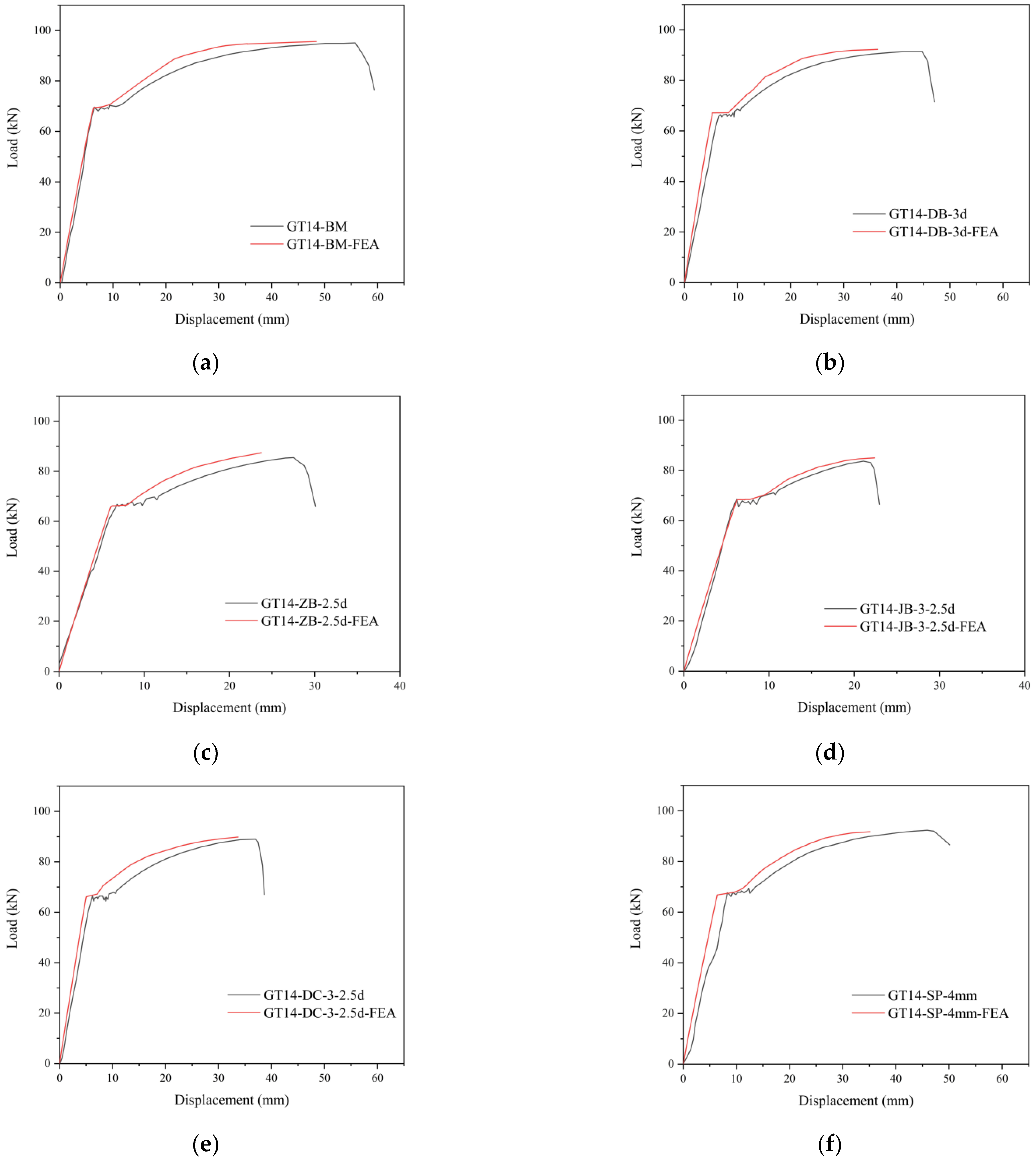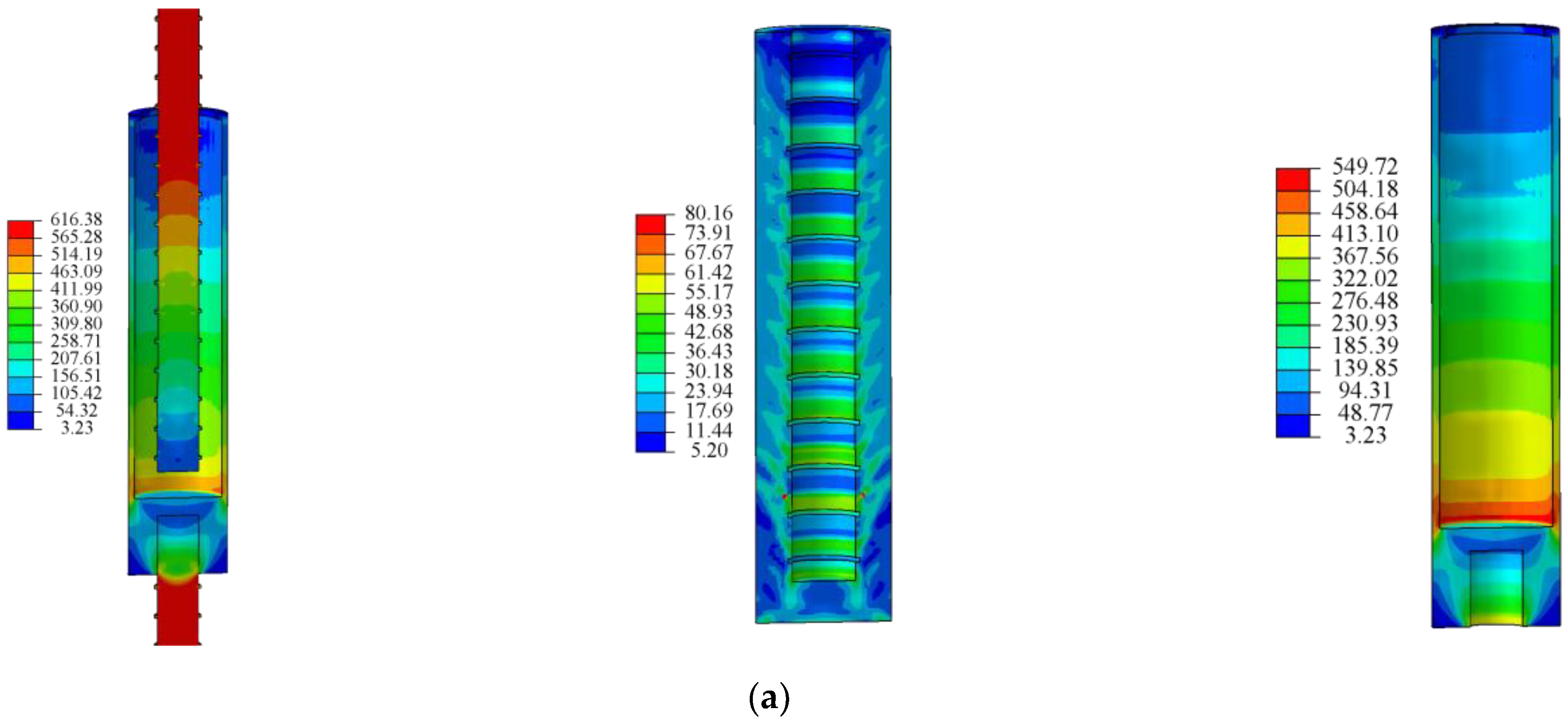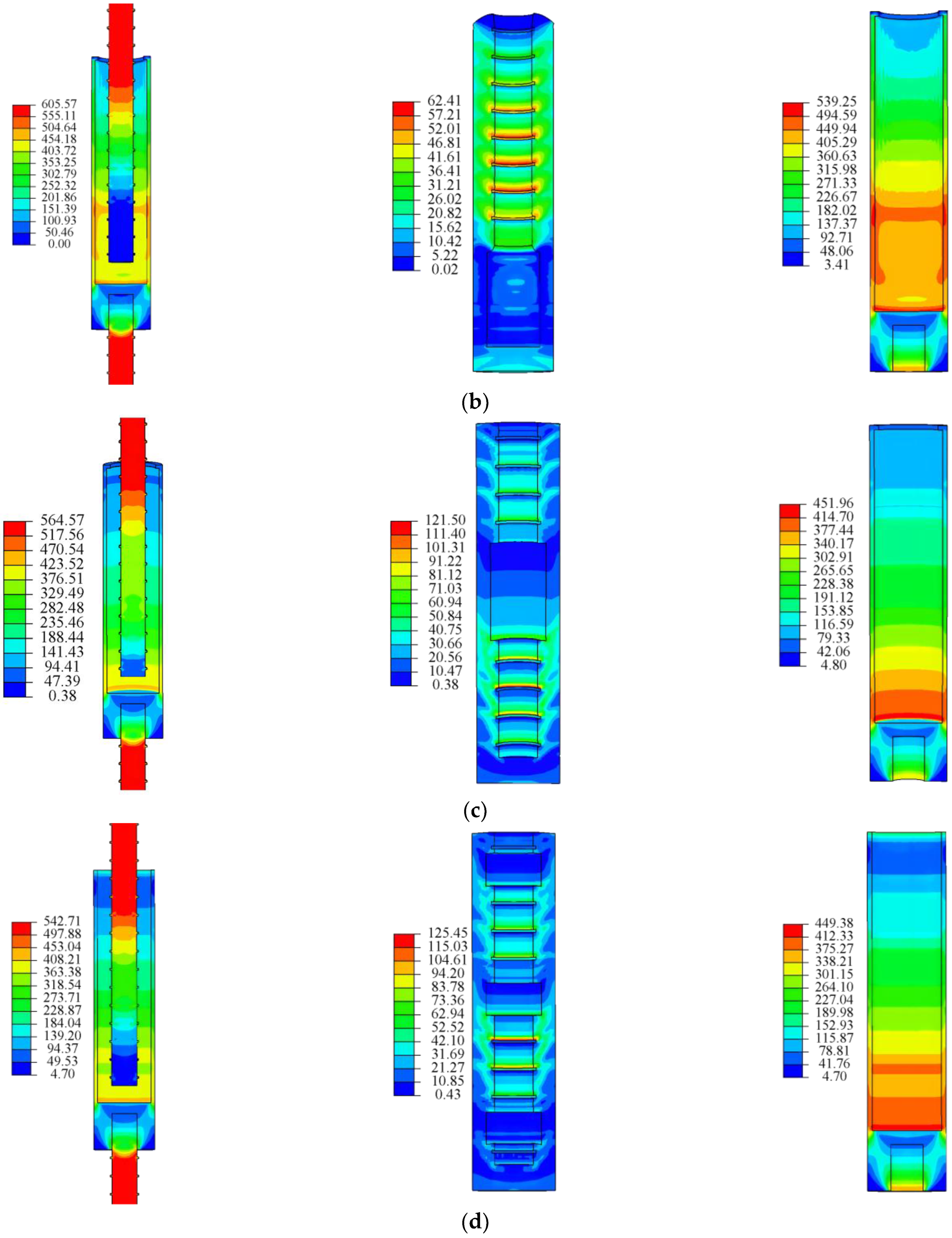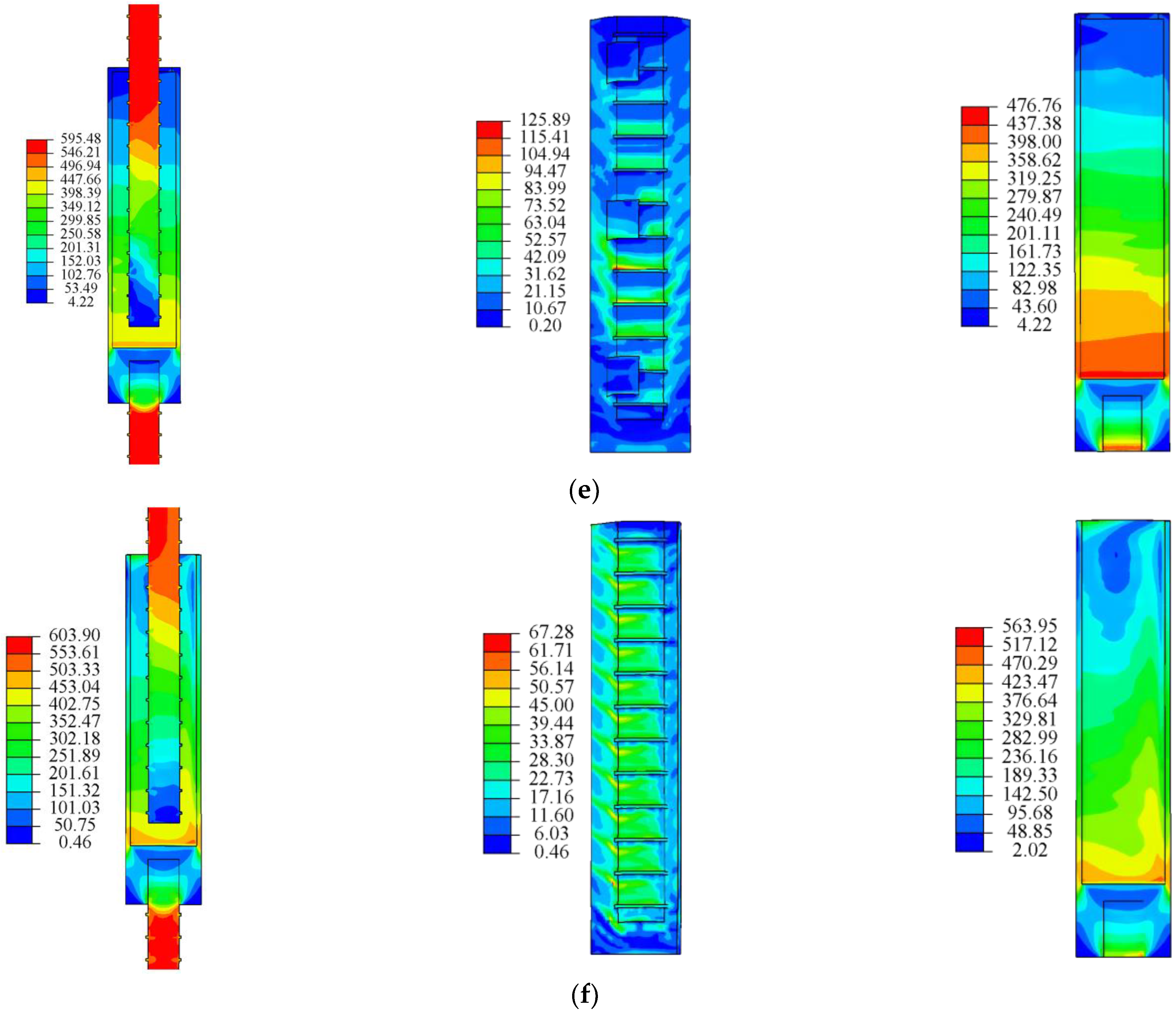1. Introduction
The construction of infrastructure in China has entered a critical period characterized by reduced emissions and energy savings. The transformation of the construction industry, which is a large carbon emitter, is imminent. Scholars study ways to reduce energy consumption and achieve green emission reduction [
1,
2,
3]. Compared with conventional cast-in-place concrete structures, prefabricated concrete structures have considerable advantages such as environmental protection, energy savings, and reduced emissions [
4,
5,
6,
7]. To ensure the safety of a prefabricated concrete structure, the overall performance of precast component nodes is important. The grouted sleeve connection technology is one of the main forms of rebar connection between components [
8]. Grouted sleeves mainly come in two forms: full-grouted sleeves (
Figure 1a) and half-grouted sleeves (
Figure 1b). Compared with a full-grouted sleeve, a half-grouted sleeve connection has a shorter connection length and higher construction efficiency. The half-grouted sleeve is mechanically connected by threads at one end and is grouted at the other end [
9,
10]. The connection performance of grouted sleeves is important for structural safety. Extensive research has been conducted on the grouting connection technology of grouted sleeves.
Depending on the environment, grouted sleeves are used with safety and cost considerations. Different grouted sleeves have been designed, and their performance has been studied by considering the inner cavity structure of the sleeve, the diameter of the rebar, the anchorage length, and the grouting material. Ling et al. [
11] proposed two new types of grouted sleeves made of standard-size steel tubes: welded bar sleeve and tapered head sleeve. The binding effect of the sleeve and the influence of the sleeve geometry on the bonding performance were studied. The load carrying capacity of the joint was found to be related to the anchorage length of the rebar. Gao et al. [
12] welded ribs on the inner wall of grouted sleeves. The effects of parameters, such as the cavity, anchorage length, and grouting strength, on the mechanical properties of the grouted sleeve were compared by conducting a uniaxial tensile experiment. The results showed that the rib spacing influences the failure mode of the joints. The grout strength significantly affects the tensile strength of the joints. Hosseini et al. [
13] designed a grouted spiral connection and showed that the spiral diameter provides more dominant binding effect than the spiral pitch distance in increasing the bond strength. The spiral connections require a larger anchorage length than the grouted steel pipe because the constraints provided by the spiral are much lower than those provided by steel pipe. Henin et al. [
14] used a non-proprietary bar to prepare a splice sleeve and considered the cost and efficiency. After adjusting the anchorage length of the rebar, the joint strength could meet the specification requirements. Currently, most grouted sleeves are expensive because of the complex manufacturing process and high-strength materials used. Designing a new type of sleeve requires analyzing the influences of the inner cavity structure, anchorage length, and rebar size on its performance. Moreover, evident advantages, such as low cost, ease of production, and high strength, are desired.
Affected by the construction environment, grouted sleeves contain grouting defects. The grouting end rebars are contaminated (
Figure 2a), the anchorage length is insufficient (
Figure 2b), and there is grout leakage (
Figure 2c). Han et al. [
15] studied the influence of grouting material strength on the sleeve bond strength. The results showed the existence of a relative slip between the rebar and the grouting material in the strengthening stage, and the relationship between the grouting material strength and bond strength was explained. Wang et al. [
16] considered the influence of three loading modes and different anchorage lengths on sleeve performance. The joint stiffness reduced significantly under cyclic loading. The energy dissipation capacity of specimens decreased with the anchorage length. The bonding stress distribution in the sleeve was significantly affected by the anchorage length. Chen et al. [
17] studied the mechanical properties of the rebar in half-grouted sleeve connections with a high water-to-binder ratio. Studies have shown that a high water-to-binder ratio leads to bond failure and increases the damage depth of the grouting end. An analytical model considering the influence of the water-to-binder ratio was established. Zheng et al. [
18] studied the influence of the grouting material content on the mechanical properties and deformation of grouted sleeve connections under static conditions. Repeated tension and compression experiments were conducted under high-stress and large-deformation conditions to study the seismic performance of the connections. The experimental results showed that the failure modes include rebar fracture and rebar pull-out, which mainly depend on the relative magnitude of the bond bearing capacity between the rebar and the grouting material and the tensile bearing capacity of the rebar. The bond bearing capacity is mainly affected by the grout content.
In previous studies, the defect types and sleeve types analyzed were different, and the grouting operation was a concealed project. Studies on the types of grouting defects have not been sufficiently comprehensive. Hence, in this work, to ensure the safety and reliability of the connection technology of half-grouted sleeves, 33 half-grouted sleeves (a standard group and 10 groups of defective specimens, with 3 in each group) were designed for possible defects in actual engineering. Uniaxial tensile experiments and numerical simulations were conducted on the specimens. The influence of grouting defects on the performance of half-grouted sleeves were analyzed by comparing the failure modes, ultimate load, and load–slip curves.
3. Results and Analysis
The failure modes were either rebar fracture (
Figure 11a) or rebar pull-out (
Figure 11b). The failure form of the specimen depended on the relative magnitude of the bond strength and rebar strength between the rebar and the grouting material. In the specimens with rebar fracture failure, the fracture section of the rebar was necked, and the grouting material was conically detached at the grouting end.
Table 9 lists the main parameters and failure modes of each specimen. The specimens, namely GT14-BM, GT14-DB-2
d, GT14-SP-2mm, and GT14-SP-4mm, all suffered rebar fracture failure. None of the specimens underwent significant changes before the rebars yielded. After the rebar yielded, the grouting material developed cracks along the rebar surface toward the inner wall of the sleeve. The grouting material peeled off in a conical shape. With increasing load, the rebar underwent necking and finally fractured. The fracture location was random: either at the anchored end or threaded end. GT14-DB-2.5
d, GT14-DB-3
d, GT14-ZB-2.5
d, GT14-JB-2-2.5
d, GT14-JB-3-2.5
d, GT14-DC-2-2.5
d, and GT14-DC-3-2.5
d specimens all suffered rebar pull-out failure. Specimens did not exhibit any significant changes before the rebar yielded. After the rebar yielded, the grouting material cracks developed along the surface of the rebar toward the inner wall of the sleeve. The grouting material peeled off in a conical shape. With increasing load, the test was stopped when the load–displacement curve dropped significantly. The rebar at the anchored end of the specimen pulled out for a distance (
Figure 11b).
3.1. Load–Displacement Curves
Figure 12 shows the average load–displacement curves of each group of specimens. The load is tensile, and the displacement is the perpendicular distance between the reaction beams of the experimental machine and the loading (
Figure 6). As shown, the load–displacement curves of the specimens are similar. The curves show elastic, yielding, strengthening, and failure stages. In the elastic stage, the load P changes linearly with the displacement δ [
23,
24,
25,
26]. The specimen then enters the yielding stage; the load remains unchanged, but the deformation increases rapidly. In the strengthening stage, the overall deformation of the specimen increases significantly. With increasing displacement, the specimen is destroyed following a gradual increase in the load.
The load–displacement curves of the GT14-DB specimens (
Figure 12a) are similar to those of GT14-BM in the elastic, yielding, and strengthening stages. The average yield load of GT14-BM is 55.10 kN, and the ultimate load is 94.41 kN. When the defect lengths are 2
d and 2.5
d, the average ultimate loads of the specimens are 93.63 kN and 93.10 kN, respectively, and the average ultimate displacements are 53.49 mm and 52.66 mm, which are slightly lower than those of the standard group specimens. When the defect length is 3
d, the average ultimate load is 90.79 kN, which is approximately 3.8% lower than those of the standard group specimens; the average ultimate displacement is 44.53 mm, which is approximately 19.2% less than those of the standard group specimens. When the length of the defect at the end of the rebar is greater than 2.5
d, the overall ductility of the specimen deteriorates rapidly.
Before yielding, the curve trend of the GT14-ZB specimens is approximately the same as the standard group specimens (
Figure 12b). The average limit load of GT14-ZB-2.5
d is 84.23 kN, which is approximately 10.8% lower than those of the standard group specimens. The average limit displacement is 26.57 mm, which is approximately 51.78% lower than those of the standard group specimens. This shows that the middle defect had a greater influence on the specimens than the end defect of the rebar. When the defect was located in the middle, the bond stress between the rebar and the grouting material was broken at the middle. The grouting material can be divided into two parts to transfer the bond stress to the rebar separately. The two parts of the grout could not reach the ultimate bond stress simultaneously. This makes the middle defect more detrimental to the specimen than the end defect.
In the GT14-JB group specimens (
Figure 12c), the average limit load of GT14-JB-2-2.5
d is 87.52 kN, which is approximately 7.3% lower than those of the standard group specimens; the average limit displacement is 28.08 mm, which is approximately 49.0% lower than those of the standard group specimens. The average limit load of GT14-JB-3-2.5
d is 83.89 kN, which is approximately 11.1% lower than those of the standard group specimens; the average limit displacement is 21.36 mm, which is approximately 61.2% lower than those of the standard group specimens. Similar to the middle defect specimens, the grouting material can be divided into multiple parts, which affected the bond stress transfer between the grouting material and the rebar. The bearing capacity of the specimens decreased with the increase in the number of defects. The impact on the specimen was more unfavorable when the number of uniform defects was greater than 2.
In the GT14-DC group specimens (
Figure 12d), the average limit load of GT14-DC-2-2.5
d specimens is 90.74 kN, which is approximately 3.9% lower than those of the standard group specimens; the average limit displacement is 41.64 mm, which is approximately 24.4% lower than those of the standard group specimens. The average limit load of GT14-DC-3-2.5
d specimens is 89.99 kN, which is approximately 4.7% lower than those of the standard group specimens; the average limit displacement is 36.97 mm, which is approximately 32.9% lower than those of the standard group specimens. The grouting material of the GT14-DC group of specimens could not be completely divided into multiple parts by the defects, and the rebar was still half connected to the grouting material in the defective section; therefore, the effect of the defects on the specimens was less than those of the uniform defects. The bearing capacity of the specimen gradually decreased with increasing number of defects.
In the GT14-SP group specimens (
Figure 12e), the average limit load of GT14-SP-2mm specimens is 94.10 kN, which is approximately 0.3% lower than those of the standard group specimens; the average limit displacement is 48.38 mm, which is approximately 12.2% lower than those of the standard group specimens. The average limit load of GT14-SP-4mm specimen is 91.44 kN, which is approximately 3.1% lower than those of the standard group specimens; the average limit displacement is 44.73 mm, which is approximately 18.8% lower than those of the standard group specimens. The bearing capacity of specimens decreased with the increase of the height of horizontal defects. Because the height of the horizontal defects of the specimens are not large, the grout material could still restrain the rebar. The failure form of the specimens were rebar fracture.
Figure 12f shows a comparison of the load–displacement curves between the different groups of specimens. All the defects influence the bearing capacity of the specimen, with the distributed defects being more detrimental to the specimen than the concentrated defects. In the horizontal defect specimens, the grout material could still restrain the rebar, and the bearing capacity decreased slightly.
3.2. Load–Slip Curves
Figure 13 presents the average load–slip curve of each half-grouted sleeve specimen. The slip is the relative displacement between the sleeve and the rebar at the anchored end (
Figure 9). The trend curve is similar to the load–displacement curve. Before yielding, the rigidity of the specimen was high. The curves show a linear variation, and the slip values are lower than 1 mm. After yielding, the load increases gradually, and the slip increases quickly. When the load reaches the ultimate load, the small slip makes the bearing capacity decline significantly [
27,
28].
Figure 13f shows a comparison of the average load–slip curves between all the groups of specimens. The eigenvalues of all the defective specimens were lower than those of the standard group specimens. The defects in the GT14-JB-3-2.5
d and GT14-ZB-2.5
d specimens caused the connection to fail rapidly after the specimens entered the strengthening phase, and the rebar pulled out prematurely. The slip of the standard group was lower than those of the other specimens.
3.3. Load–Stress Curves
Figure 14 shows the typical load–stress curves. On the sleeve surface, the axial stress was tensile, and the circumferential stress was mainly compressive. The longitudinal extension of the sleeve under a tensile load causes Poisson’s effect. The axial and circumferential stresses increased linearly in the early stage. With increasing load, cracks appeared around the contact surface between the grout material and the rebar, causing the grouting material to expand. The grouting material was restrained by the sleeve. The stress state of the sleeve surface was determined by the stretching of the sleeve and the expansion of the grouting material [
29,
30]. As shown in
Figure 13, the axial stresses are minimum at T1 and maximum at T2 and T3. Because the cross-sectional area of the sleeve reduced between T1 and T2, the maximum axial tensile stress and the maximum circumferential compressive stress in the sleeve were 240.18 MPa and 96.38 MPa, respectively. The stresses were lower than the yield stress of the sleeve. This indicates that the sleeve met the strength requirements.
3.4. Stress Distribution Curves
Figure 15 shows the stress distribution curves of the rebar and sleeve at different positions when the load reaches 20, 40, and 60 kN.
Under the same load, the rebar stress increases from the threaded end to the grouting end. The stresses at each position of the rebar increase with the load. When the load reaches 60 kN, the maximum stress at G1 is 92 MPa, which is still lower than the yield stress. The rebar stress near the grouting end is close to the yield stress. The rebar stress distribution curves of the GT14-DB-2d, GT14-DB-2.5d, GT14-DB-3d, GT14-ZB-2.5d, GT14-JB-2-2.5d, and GT14-JB-3-2.5d specimens are smooth, indicating a uniform rebar distribution at the defect of the specimen. The stress values of GT14-DC-2-2.5d and GT14-DC-3-2.5d specimens decrease sharply at G4 and G5, indicating that unilateral defects would make the stress unevenly distributed at the defect positions. The stress distribution curves of the GT14-SP-2mm and GT14-SP-4mm specimens show that the stress distribution is unaffected by the defect height.
The sleeve stress was minimum because T1 was on the side of the rebar threaded end, where the sleeve section area was large. Except for T1, the stress on the sleeve decreased from the threaded end to the grouting end. The stress at each position increased with the load. The GT14-DB-2d, GT14-DB-2.5d, and GT14-DB-3d specimens exhibited the maximum stress at G3. The stresses of the GT14-DC-2-2.5d and GT14-DC-3-2.5d specimens dropped sharply at T5 and T3. The stress distributions of the specimens with uniform and horizontal defects were largely the same as those of the standard group, and the defects had little effect on the stress distribution.
3.5. Stress Transfer Analysis
The cohesive force between the rebar and the grouting material comprises the frictional force, chemical adhesive force, and mechanical bite force. The frictional force is mainly determined by the roughness of the contact surface and the pressure exerted by the expansion of the grouting material on the rebar. The surface of the grouting material has a chemical adhesive force. The mechanical bite force plays a key role, mainly provided by the transverse rib. The stress distribution at the grouting end of the specimen under a load of 45 kN was selected to study the stress transfer law between the rebar and the sleeve, as shown in
Figure 16. The position of the rebar strain gauges (G1–G5) corresponds to that of the sleeve strain gauges (T2–T6).
The rebar stress of the GT14-BM specimen showed a decreasing trend from G5 to G1. On the contrary, the sleeve stress showed an increasing trend from T6 to T2. Because of the high strength and expansibility of the grouting material, the sleeve had a constraint on the grouting material. Therefore, during uniaxial tension, the grouting material can be used as a good medium to transfer the stress of the rebar to the sleeve. The stress distribution curves show that the specimen is subjected to load by the rebar and sleeve. Near the threaded end, the load is mainly borne by the sleeve. In terms of the stress transfer path, the rebar at the grouting end transfers the load to the threaded end through the grout material and the sleeve.
The stress transfer path in the defective specimen was the same as that in the standard group specimen. The GT14-DB-2.5
d, GT14-DB-3
d, and GT14-ZB-2.5
d specimens showed blocked stress transfer at the defects. Taking the stress distribution curve of the GT14-ZB-2.5
d specimen as an example, the stresses of the G1–G5 specimens were 59.8, 153.5, 168.7, 203.4, and 490.5 MPa, respectively. The stresses of the T2–T6 specimens were 115.2, 80.6, 70.2, 63.1, and 9.5 MPa. The stress of G2–G4 on the rebar was similar, and the stress of T3–T5 on the sleeve was also similar. Because there was no bond between the rebar and the grouting material at the central 2.5 d defect, the stress on the rebar is not transferred to the sleeve, thus making the stress of the rebar and sleeve more uniform at the defect. As shown in
Figure 15h,j, the lower side of the GT14-DC-3-2.5
d and GT14-DC-2-2.5
d specimens is the defect side, and the upper side is the dense side. The stress of the GT14-DC-3-2.5
d specimen changed suddenly at G4–G5, and the stress of the GT14-DC-2-2.5
d specimen changed suddenly at G3–G5. There was no cohesive force between the rebar and the grouting material in the defect side, and the stress of the rebar changed slightly at the defect side. The stress on the dense side of the rebar decreased continuously, resulting in an uneven stress on both sides of the rebar. The eccentric tension of the specimen resulted in a sudden decrease in the stress of the rebar and sleeve at the dense side of the grouting end of the specimen. Because the GT14-JB-3-2.5
d and GT14-JB-2-2.5
d specimens had no bonding force between the rebar and the grouting material at the defect side, the stress of the rebar was largely the same, and there was no obstruction to the stress transfer. The stress transfer trends of the GT14-SP-2mm and GT14-SP-4mm specimens were consistent with that of the standard group.


